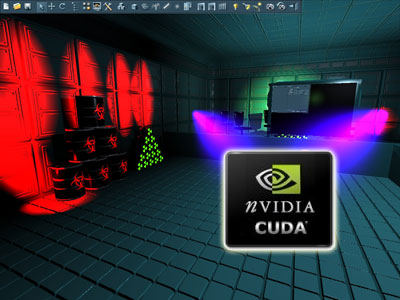A few months ago, NVIDIA broke the news that they have acquired physics-processing company AGEIA, which manufactures the PhysX add-on card which didn’t do so well in the market. The result of that acquisition is only now starting to appear.

A little bit of history lesson first; when NVIDIA first launched their Geforce 8 series of GPUs (Graphics Processing Unit, because graphics card is so last century), it represented a new architecture that includes what is known as CUDA. CUDA is a type of C programming language which is used specifically for these Geforce 8 GPUs. CUDA allows programmers to write programs which can be run from inside the graphics card itself, turning the GPU into a general-purpose processor, albeit like a CPU but with some differences.
That was some 2 years ago. Today, NVIDIA have already launched their Geforce 9 series and then moved on to their GT200 series, maintaining and upgrading the CUDA capabilities of each generation of cards, but without any observable benefit to the public. When will developers start using CUDA?
The marketing team at NVIDIA certainly promised a lot back when they were hyping up CUDA. The company claims that the GPU is a much more efficient and powerful processing engine than processors from AMD and Intel at certain tasks. This is due to the fact that while your PC may have dual core, or at best quad cores, GPUs are approaching in excess of 600 cores in a single chip. However, unlike traditional Intel and AMD CPUs, these cores are smaller and less able to perform complicated tasks. So you still need CPUs around to run all the heavy processing for you.
NVIDIA promised that programmers will be able to reprogram these hundreds of cores to do whatever they want with CUDA, and things like physics processing is the first to be mentioned as potential candidates to be processed in the graphics card. That got the attention of gamers everywhere because traditionally, CPUs are used to calculate in-game physics and it consumes some 40% of processing power. By offloading this mundane task to the graphics card, the processor is freed to do other things while the efficient architecture of the GPU makes crunching the numbers an easy task. This proposition sounds very cool, but not really feasible until a few months ago when NVIDIA announced their acquisition of AGEIA, and immediately making a special announcement.

The announcement is that AGEIA’s PhysX technology will be converted completely into CUDA code and then released it for FREE to all NVIDIA customers. This means that all the physics processing capabilities of the PhysX add-on card can now be used by any NVIDIA GPUs sporting CUDA capabilities (Geforce 8 and above). The performance gain is astonishing as many websites started downloading the ‘early Christmas gift’ and performing benchmarks using 3D Mark’s Vantage. In some cases, physics performance was improved more than 10 fold.
What this means is that any future games which support PhysX will gain a performance boost when run with NVIDIA cards, a trump card that might bring them some reprieve from AMD/ATI’s current domination of the market with their Radeon 4000 series of cards. ATI has answered NVIDIA’s challenge by acquiring Havok physics technologies for their cards, but that is another different story which will not be explored today (ATI cards to not have an equivalent to CUDA currently).
But that’s not the end of the CUDA story. Another great development is the capability of allowing CUDA-enabled GPUs to transcode video from one format to another. This is demonstrated with the Badaboom video converter which is currently available for beta testing. It promises to cut down video encoding speeds and by using the GPU, the CPU is freed to do other tasks. In the past, whenever we do any sort of video encoding, the CPU resources is used up and the whole computer slows down, but this is no longer the case and I am sure many video afficianados welcome this development with open arms.

Finally, even Adobe is interested in harnessing CUDA technology. The company recently demonstrated a plugin for their Photoshop that allows it to edit multi-gigapixel photos in real-time without any discernible slow-down by using the GPU to handle processing tasks. It seems that the CPU is fast becoming obselete when faced by the might of massively parallel processing units in the GPU. It looks like NVIDIA is finally making good of it’s promise so many years ago.
If you own a CUDA capable GPU, head on now to NVIDIA’s website now where you can download all these goodies, and even some technology demos of upcoming games which have incredible in-game physics thanks to PhysX. The website is called Force Within, and I couldn’t agree more; NVIDIA holds a series ace in the sleeve with their CUDA technology, and now it’s only starting to show it.
